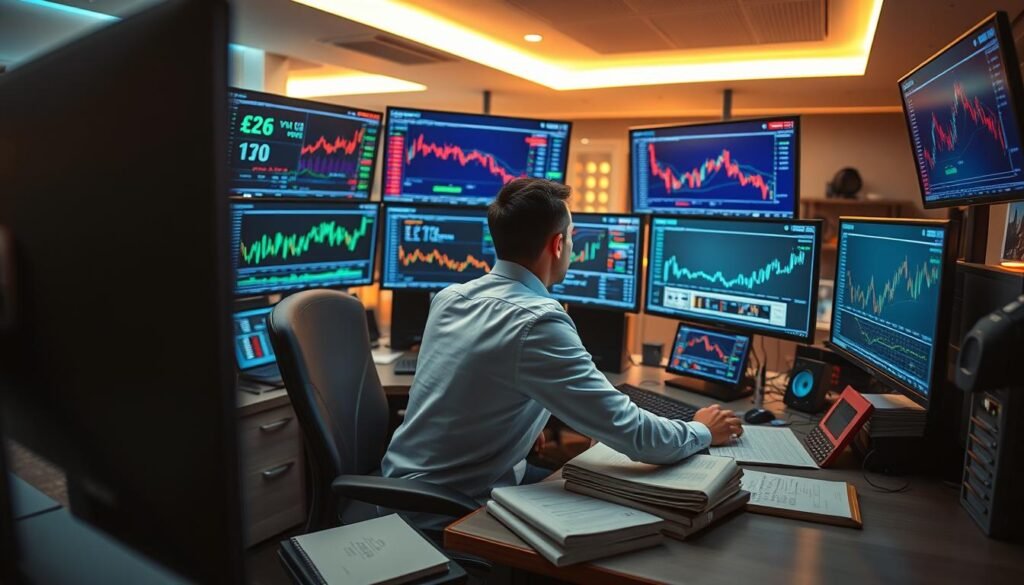For ambitious traders, the path to financial success seems full of obstacles. Proprietary trading firms offer a way to overcome these hurdles. They provide a structured path for talented individuals to grow.
Understanding how to get funded by these firms is key. This guide will help you unlock this opportunity. You’ll learn how to increase your trading capital and improve your career.
We’ll explore trader funding programs and proprietary trading firms in detail. You’ll get a clear step-by-step guide to get the funding you need. Start your journey to financial success today.
Key Takeaways
- Discerning the roles and opportunities provided by proprietary trading firms.
- Unveiling the process and benefits of trader funding programs.
- Navigating the prerequisites for securing trading capital from a prop firm.
- Key insights into preparing a compelling application for trader funding.
- A step-by-step roadmap for aligning with a prop firm’s funding criteria.
- Strategic guidelines for sustaining and expanding the funding obtained.
Understanding Proprietary Trading Firms
Proprietary trading firms play a big role in the finance world. They use their own money to trade directly in the market. This way, they can make quick decisions without worrying about clients.
What is a Prop Trading Firm?
A prop trading firm uses its own money to trade different financial products. Unlike regular brokerages, these firms take all the risks and rewards themselves. They use advanced tech to manage their trading and make profits from the market.
The Benefits of Trading with a Prop Firm
Trading with a proprietary firm has many benefits:
- Access to Larger Capital: Traders get to use more money than they could on their own.
- Advanced Trading Technologies: These firms use the latest tech to improve trading.
- Professional Growth: They offer a great place to learn and grow as a trader.
Types of Prop Firms: Which One is Right for You?
Choosing the right prop firm is key to your trading success. Here are the main types:
- Equity Trading Firms: These focus on stocks and often involve day and swing trading.
- Forex Trading Firms: They specialize in currency markets, perfect for those who like a 24-hour market.
- Options Trading Firms: Ideal for those interested in derivatives and securities that offer the right but not the obligation to buy or sell assets.
Knowing the different types of proprietary trading firms can help you choose the best one. It can improve your trading strategies and fit your financial goals and risk level.
Eligibility Criteria for Trader Funding Programs
Aspiring traders often look to join trader funding programs. These programs offer access to big capital without needing to pay first. But, getting into these programs requires meeting certain criteria. This includes a detailed evaluation process and strong risk management skills.
It’s important for potential candidates to know what’s needed. Proprietary trading firms want traders who are skilled technically. They also look for those who understand the market well and can manage risks effectively.
Many firms use an evaluation process to check if a trader can handle pressure and make smart decisions. They also look at how well a trader can manage financial risks. This step is key to making sure only the best traders get funding.
- Proven trading track record
- Familiarity with trading platforms and tools
- Understanding of financial markets
- Effective risk management strategies
For those new to trading, building a good trading history and learning more about the markets is wise. This can help them pass the evaluation process with flying colors.
The evaluation process is not just about technical skills. It also shows how important risk management is. It helps keep profits up and capital safe, no matter the market conditions.
| Requirement | Details | Impact on Funding Eligibility |
|---|---|---|
| Trading Experience | Minimum of two years | Critical for advanced funding levels |
| Market Knowledge | Understanding of market mechanics and strategies | Essential for strategy development and risk management |
| Risk Management | Proven strategies to minimize losses | Directly impacts profitability and sustainability |
Meeting the strict criteria of trader funding programs can improve a trader’s skills. It also shows they are ready to handle big trading funds wisely.
Preparing to Apply for Prop Firm Funding
Getting ready to apply for funding from a proprietary trading firm? It’s key to know what makes a strong application. A good strategy, the right tools, and a strong mindset are essential. These elements can make you stand out as a top candidate.
Building Your Trading Strategy
Creating a solid trading strategy is your first step. It should be profitable and well-documented. It shows you understand the market and how to manage risks. Use both technical and fundamental analysis to make your strategy stronger.
Essential Trading Tools and Resources
Using advanced trading tools is crucial for better performance. You need software for deep analysis and smooth trading. Tools like trading platforms, charting software, and economic calendars are key for any professional trader.
Developing the Mindset of a Professional Trader
Understanding trading psychology is key for success. It’s about discipline, stress management, and being flexible. Prop firms want traders who handle money and emotions well, even in tough markets.
Keep these tips in mind as you prepare your application. Show your technical skills, but also your mental strength and planning. A balanced approach will help you impress potential funders.
| Component | Importance | Tools/Resources |
|---|---|---|
| Trading Strategy | Core element of the trading plan | Technical indicators, economic reports |
| Trading Tools | Essential for analysis and execution | Trading platforms, charting software |
| Trading Psychology | Crucial for decision-making and stress management | Mental training, discipline practices |
How to Get Funded by a Prop Firm: Step-by-Step Guide
Getting funding from a proprietary trading firm can boost your trading career. It gives you a lot of trading capital without your own risk. Follow this guide to learn about trader funding programs and how to get through each step.

- Identify firms that align with your trading style and goals.
- Evaluate the trader funding programs offered, focusing on terms and profit sharing.
Step 2: Application Submission
- Complete the application forms with necessary personal and professional details.
- Submit previous trading performance reports if required.
Step 3: Initial Assessment
Candidates might need to pass a trading skills test. This could include simulated trading or analyzing past trades.
Step 4: Interview
Some firms will interview you. They want to know about your trading strategy and how you manage risk. They check if it fits their firm’s values.
Step 5: Funding and Account Set-Up
- After passing all tests and interviews, you get funded.
- You’ll get trading capital as agreed in the funding program.
Step 6: Trading and Growth
Start trading with the given capital. The firm will watch your performance. Good results can lead to more capital and growth within the firm.
| Phase | Description | Duration | Outcome |
|---|---|---|---|
| 1. Research | Analyze and select the right prop firm. | 1-2 weeks | Shortlist suitable firms. |
| 2. Application | Submit necessary documentation and past trading data. | 3-5 days | Application processed. |
| 3. Assessment | Performance assessment through simulated trading or data analysis. | 1-3 weeks | Eligibility decision. |
| 4. Interview | Discussion about trading strategies and philosophy. | 1 hour | Further qualification assessment. |
| 5. Funding | Allocation of initial trading capital. | Immediate post-approval | Begin trading activities. |
By following this guide, traders can increase their chances of getting into top trader funding programs. Show your trading skills and risk management discipline. This builds trust and shows you fit with the firm’s goals.
The Evaluation Process Explained
Traders aiming to get funding from trading firms must go through a detailed evaluation. It’s key to know what prop firms look for, like performance and risk management. This knowledge is crucial for success.
What to Expect During the Evaluation
Traders face a simulated or live trading test. It’s like real trading but in a controlled setting. They must show they can trade well and manage risks wisely.
Key Performance Metrics Monitored by Prop Firms
Prop firms check a few important things. They look at the risk-reward ratio, profit consistency, and risk management. They also watch how well traders manage their drawdowns and grow their profits.
Pitfalls to Avoid During Evaluation
Stay away from common mistakes like overtrading and emotional trading. Also, don’t ignore risk management rules. High-risk trades and breaking trading limits can hurt your evaluation.
| Common Pitfalls | Impact on Evaluation | Risk Management Advice |
|---|---|---|
| Overtrading | Negative impact on risk-reward profile | Establish strict trade limits |
| Ignoring Loss Limits | Potential for significant drawdowns | Adhere to stop-loss rules |
| Emotional Trading | Leads to inconsistent performance | Maintain trading discipline and objectivity |
Understanding the evaluation process is key. Focus on the metrics prop firms care about and avoid common mistakes. It’s not just about making money. It’s also about managing risks well and sustainably.
Creating an Impressive Trading Track Record
To become a professional trader, you need a strong trading track record. This attracts firms and shows you can manage a portfolio well. A detailed history of your trades highlights your strategic skills and profit-making ability.
Building a solid trading track record means keeping detailed records of each trade. You should note the date, asset, entry and exit prices, and why you made the trade. This careful documentation proves your trading and portfolio management skills.
The table below shows key parts of a trading track record for professional traders. These elements make your record more readable and impactful for firms:
| Component | Description | Importance |
|---|---|---|
| Trade Date | The specific dates on which trades were executed. | Establishes a timeline of trading activity. |
| Asset Type | Type of instruments traded (stocks, forex, etc.). | Highlights expertise in specific markets. |
| Price Entry | The entry price of the trade. | Essential for performance assessment. |
| Price Exit | The exit price of the trade. | Indicates the profitability and timing accuracy. |
| Trade Rationale | Reason for initiating and exiting the trade. | Reflects strategic thinking and market analysis skills. |
For those aiming to show professionalism and trading ability, a detailed trading track record is crucial. It helps in managing a portfolio and shows your decision-making and discipline. Keeping your trading log up to date captures your journey to becoming a professional trader.
Demonstrating Risk Management Skills to Prop Firms
Learning to manage risks well is key for traders wanting funding from prop firms. This part talks about why good risk management is important. It also shows how traders can prove they’re good at handling trading capital to get past common funding hurdles.
Why Risk Management Matters
Risk management is vital for a trader’s long-term success. It keeps trading capital safe from big losses. It also shows prop firms that a trader is careful and disciplined.
Good risk management means sticking to solid strategies. This helps traders avoid big losses and make the most of their gains. This makes them stand out to prop firms looking to fund traders.
Tools for Effective Risk Management
- Stop-Loss Orders: A key tool to limit losses on trades. By using stop-loss orders, traders control how much of their capital they risk.
- Risk/Reward Ratio Calculators: These tools help traders pick trades with the best risk-to-reward ratios.
- Portfolio Diversification Software: This software helps spread investments across different areas. It reduces the risk of big losses from one sector.
Communicating Your Risk Management Strategies
When talking to prop firms, it’s important to clearly share your risk management plans. Traders should be ready to explain how they use their tools and strategies to manage risks. This openness builds trust and shows their skill in protecting trading capital.
Being good at managing risks sets traders apart in a competitive market. It’s a key part of getting past funding challenges. By clearly sharing and using these strategies, traders can improve their chances with prop firms.
Advancing through the Trader Funding Levels
Traders start with a small amount of trading capital in trader funding programs. Moving up requires strategic steps and understanding trading psychology.

Success in trader funding levels needs skill, discipline, and mental toughness. Here’s what traders must do to move up:
- Initial Assessment: Traders begin with a simulated trading environment. It tests their trading skills and psychology.
- First Funding Level: After passing the assessment, traders get their first real capital. It’s a small amount but a real test of their strategies.
- Progressive Capital Increase: Traders must meet profit targets and manage risks well. This earns them more trading capital.
- Mastery and Scaling: At higher levels, traders handle big capital. They need mature trading psychology and smart risk strategies.
Each level in trader funding programs brings new challenges and learning. These are key for growing as a trader.
| Funding Stage | Capital Range | Key Focus Area |
|---|---|---|
| Beginner | $1,000 – $5,000 | Basic Trading Skills |
| Intermediate | $5,000 – $20,000 | Risk Management |
| Advanced | $20,000 – $50,000 | Strategy Refinement |
| Professional | $50,000+ | Psychological Resilience |
The path through trader funding programs is both challenging and rewarding. Success depends on market savvy and trading psychology. Mental toughness is key to managing trading capital well.
Scaling Up: Managing Increased Trading Capital
As traders grow and get more funding from firms, managing more capital is key. This part of the article dives deep into how to use more money wisely for growth and profit.
Adjusting Your Strategy for Larger Capital
Using more capital means you need to tweak your strategy. It’s vital to improve your risk management to protect your money while aiming for bigger gains. Making smart changes can boost your success and keep your investment safe from big losses.
Balancing Risk and Reward with Bigger Trades
With more capital, balancing risk and reward is more important. Traders must think about the risks of bigger trades and how much to risk. Finding the right balance helps you earn more without risking too much, which is key for a long trading career.
Portfolio Diversification at Higher Funding Tiers
Diversifying your portfolio is crucial with more capital. It helps spread out risk and smooth out returns. By investing in different areas, you can avoid big losses and get more consistent gains.
Key Considerations for Portfolio Diversification:
- Spread investments across various financial instruments to minimize risk.
- Include a mix of growth and value assets to capture diverse market dynamics.
- Regularly reassess and realign your portfolio to maintain optimal balance.
| Trading Capital Level | Risk Management Techniques | Recommended Diversification Strategies |
|---|---|---|
| $50,000 – $100,000 | Strict stop-loss orders, Controlled leverage usage | Equities, Bonds, Commodities |
| $100,001 – $500,000 | Dynamic hedging, Advanced derivatives | Foreign Exchange, Index Funds, Real Estate |
| $500,001 and above | Portfolio insurance, Diversification across global markets | Cryptocurrencies, Emerging Market Bonds, Private Equity |
Trading Psychology: The Key to Sustained Success
The heart of trading psychology greatly affects the success of traders in prop firms. Traders face not just the markets but also their own mental challenges. These come from the risks and pressures of managing big amounts of money. We explore the key ideas and strategies for keeping a healthy mindset.
Understanding the Psychological Challenges of Trading
Trading in financial markets requires more than just knowing the technical side. It also needs a strong mental game. Emotions like fear, greed, and high expectations can greatly affect how traders make decisions. For those facing trader funding challenges, the mental pressure is even greater. They must meet strict performance standards set by their funding firms.
Cultivating Discipline and Patience
Discipline and patience are essential for any trader’s success. Building these traits helps keep a consistent approach, no matter the market. This is especially important for those funded by proprietary firms. Consistent performance is key to a long and profitable trading career.
Managing Stress and Emotions While Trading
Managing stress and emotions is a critical part of trading psychology. Traders need to find ways to deal with the emotional ups and downs of trading. Practices like mindfulness, regular breaks, and a balanced lifestyle can help.
- Regular evaluation of personal trading logs to identify emotional triggers.
- Setting realistic trading goals to avoid undue stress.
- Using risk management tools to protect against significant losses.
By adopting these strategies, traders can better handle the mental demands of the job. This not only improves their mental game but also enhances their trading strategies. It helps them overcome the tough conditions set by trader funding challenges, leading to a successful and lasting trading career.
Effective Portfolio Management Tactics
Mastering portfolio management is key for traders wanting to grow their assets and keep their investments safe. Using strong risk management and a flexible trading strategy helps manage market ups and downs well.
Knowing how to spread investments across different types of assets is vital. This mix of investments reduces risk and can lead to better returns. It helps balance the portfolio against possible market drops.
Here’s a table showing how to mix risk management with trading strategy for a strong portfolio:
| Component | Role in Portfolio Management | Impact on Risk Management |
|---|---|---|
| Asset Allocation | Distributes investments across various financial instruments | Reduces potential losses by not overexposing to one sector |
| Sector Diversification | Balances investments across multiple sectors | Protects against sector-specific downturns and volatility |
| Strategic Adjustment | Responsive adjustments to market conditions and economic indicators | Allows for proactive risk mitigation before potential downturns |
Using these tactics in your trading can greatly improve your ability to handle complex market situations. It helps keep your investments safe while aiming for the best returns.
So, portfolio management, risk management, and trading strategy should guide your investment choices. They should match your financial goals with market chances and risks.
Navigating Trader Funding Challenges
Starting as a professional trader comes with many hurdles, like finding enough money to trade. It’s key to know these trader funding challenges to move forward. Focusing on trading psychology and smart strategies can help beat these issues.
Common Obstacles in Securing Funding
Many face funding problems due to lacking trading records or poor risk management. It’s tough to show you’re reliable and profitable to firms. These are key for them to invest in you.
Strategies for Overcoming Setbacks
- Change your trading strategy to fit what funding firms want.
- Show your past performance with solid numbers in your trading plan.
- Practice in simulated trading to improve without risking money.
Continued Learning and Adaptability
To succeed as a trader, keep learning and being flexible. This is true for technical skills, market knowledge, and trading psychology. Managing emotions is as crucial as managing money.
| Challenge | Strategy | Outcome |
|---|---|---|
| Limited initial capital | Look for smaller funding programs to start. | Get into bigger funding chances over time. |
| High competition | Find a unique trading strategy to be noticed. | Get more attention from prop firms. |
| Psychological stress | Practice good mental health and training. | Make better choices when under pressure. |
By grasping the complex world of trader funding challenges, using specific strategies, and staying adaptable, you can boost your chances of success. The path of a professional trader is ongoing and requires dedication and toughness at every turn.
Key Considerations Before Partnering with a Prop Firm
Thinking about joining a proprietary trading firm means looking at a few key things. You need to check how they handle trading capital, understand their trading psychology, and see how they operate. These are all important for a good partnership.
Choosing the right proprietary trading firm is not just about the financial aspects; it’s equally about aligning with a firm whose tools and culture foster your development as a trader.
Prop firms offer different ways to share profits and support systems. Each is made for different traders. It’s important to match these with your trading style and goals.
| Feature | Description | Impact on Trader |
|---|---|---|
| Profit Sharing | The percentage of profits returned to traders from successful trades. | Higher percentages can significantly increase potential earnings. |
| Support Systems | Includes educational resources, technology tools, and mentorship. | Boosts trading psychology and skill set, critical for long-term success. |
| Cultural Fit | The alignment of firm values with personal ethics and trading philosophy. | Enhances comfort and confidence, reducing stress and promoting productivity. |
Responsibilities of both parties in the partnership should be clear from the onset. Traders must understand their roles in managing trading capital responsibly, while the firms should provide a transparent reporting and feedback mechanism to foster growth and trust.
- Legal and contractual obligations
- Expected trading strategies and risk management protocols
- Goals for scaling trading capital over time
Before signing any agreement, it’s wise to ask about the firm’s operations and flexibility. This is key for adjusting to market changes and personal needs. Remember, trading psychology is crucial for staying focused and resilient during different trading times.
Maximizing Your Earning Potential with a Prop Firm
Working with a proprietary trading firm can really boost your income and grow your trading career. But, the real challenge is using the resources wisely to increase your earnings. It’s key to understand the value of trader funding programs. They offer more than just money; they help you grow.
You need to use the money well by following the firm’s rules and showing consistent results. This proves you’re a skilled trader.
Every proprietary trading firm looks for traders who know the market well and can make a lot of money. As a trader, you should always be improving your skills. Use the firm’s tools and data to make smart choices that can make you more money.
Success in trading requires being able to change your approach and predict market changes. This skill takes time and practice, with the help of the firm’s resources.
To become a top trader, you need to keep learning and growing. As you earn more, make sure to keep improving your skills. The support from your trading firm is important, but your hard work and dedication are what will really make you succeed.
Make every trade count, manage risks carefully, and always look for ways to get better. This is how you reach your highest earning potential in a prop firm.












